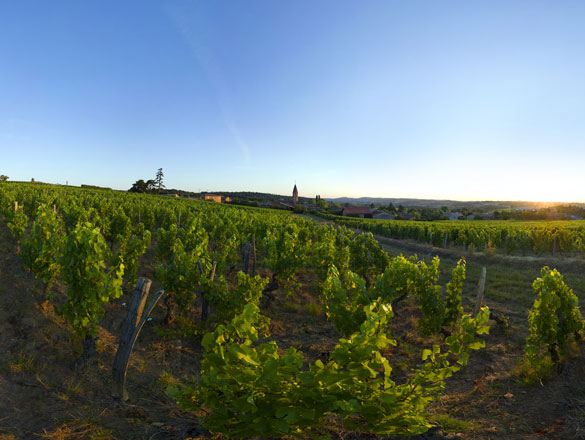

The vineyards of Bourgogne produce some great wines with a historical and international reputation. However, the region is not simply limited to its iconic appellations. In addition to its Village Premier Cru and Grand Cru AOCs, it also produces a range of wonderful Régionale and Village appellations to explore.
You will also find a full list of the Bourgogne’s Climats and lieux-dits on this page.
Check out the complete list of the 84 Bourgogne appellations.
However, your exploration has only just begun. Bourgogne wines have never before offered such high quality. Besides our range of internationally celebrated wines, try some of our lesser-known appellations where there are lots of surprises in store.
And for a fun way to find out more about the wines on offer, try out our “Which Bourgogne wine is right for me?” quiz, or check out Bourgogne Maps to take an interactive tour of the region.
Village appellation
VIGNOBLE DU MÂCONNAIS
27 avril 1940,
Whites exclusively - Chardonnay.
Area under production *:
1 hectare (ha) = 10,000 m2 = 24 ouvrées.
34.10 ha
Average annual yield **:
1 hectolitre (hl) = 100 litres = 133 bottles.
1,645 hl
*In 2022 **5-year average, 2017-2021
Appellation Village of the Mâconnais region (Saône-et-Loire).
This appellation may be followed by the name of the Climat of origin.
Producing commune: Loché.

This great dry white wine expresses the quintessence of the Chardonnay grape through its elegance and its fruit. It may be enjoyed in a number of different ways and different circumstances. When young, its greeny-gold colour and nose of acacia and hawthorn flowers qualify it to be drunk as a pre-dinner drink. Its freshness reveals aromas of peach and lemon or grapefruit. After 3 to 5 years in the bottle (depending on the vintage), its gold turns to amber and more complex notes emerge, ranging from pear and apricot to quince and dried fruits, hazelnut or toasted almond, or even gingerbread. There is wide variation between Climats in this appellation so Pouilly-Loché may turn out opulent and silky or friskier and more mineral. In any case, it always retains its balanced structure which ensures a long finish in the mouth.

White: Lively and upright, its aromatic spectrum permits characterful - even daring - matches such as smoked salmon on toast, shrimp, spring-rolls, or sushi. It is a natural partner for oysters, crustaceans and seafood. Noble sea or river-fish (boiled or grilled), poultry (oven-roasted or in cream sauce), and chicken with freshwater crayfish (poulet aux écrevisses) are classic festive dishes to match it with, but Pouilly-Loché may also accompany white-meat dishes with vegetables, guinea fowl with olives, and exotic meat dishes such as pork with pineapple or sweet potatoes, as well as tandoori chicken. It can readily be enjoyed with goat cheeses such as the Mâconnais own bouton de culotte and, if it has been oak-aged, can stand up to a truculent Beaufort or even an Epoisses.
Serving temperature: 11 to 13°C.

The village of Loché lies 5 km South-West of Mâcon on a site where vines have been grown since Roman times. Excavation for TGV station (an hour and forty minutes to Paris and Geneva) uncovered the foundations of a large Roman villa. At a later date, the vineyards prospered under the Benedictine monks of whom a reminder exists in the form of a magnificent 12th century bell-tower to which the Rocks of Solutré and Vergisson form a backdrop. Cellars and vattinghouses dating back to the 17th century are witness to the long-standing vitality of these vineyards which has persisted to the present times. Though one of the smallest of appellations Bourgogne in terms of area, the adaptability and dynamism of its winemakers show no sign of fading with time.

The Pouilly-Loché vineyards occupy a section of East-facing hillside overlooking the valley of the Saône at an altitude of 200 to 250 metres, ideally suited to the Chardonnay grape, thanks to the sunny autumns which go with the continental climate in these parts. The landscape of the Mâconnais was fashioned by the numerous geological faults dating back to the secondary era and thus, despite the small area of the appellation, its terroirs are varied and complex. To the North of the village are older soils containing schists and sandstones which warm up quickly in the sun. In the South, towards Vinzelles, are clay-limestone soils, rich in iron, which closely resemble those of Vinzelles. This diversity of soil types is largely responsible for the variations in typicity between the different Climats.
